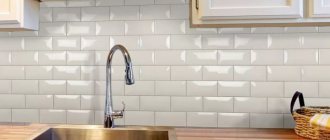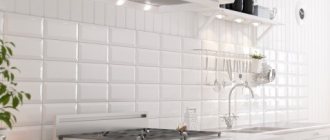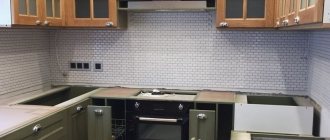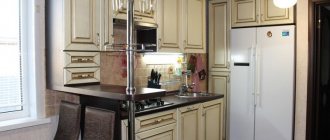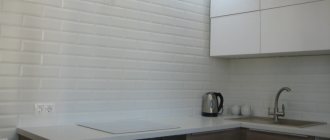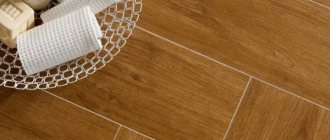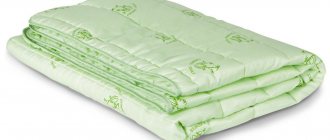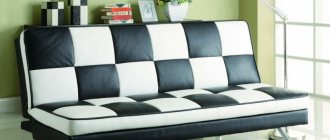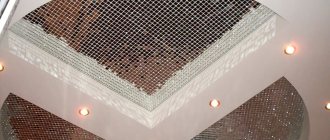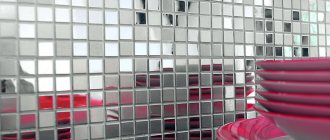The interior of any room consists of many details that should harmoniously complement each other. In the kitchen, one of the important elements is the apron. It is not only designed to beautifully decorate the workplace, but also protects the wall from dirt and other influences.
Boar tiles are increasingly being used for backsplashes. What it is and what interior it fits into, we will find out further.
What is a hog tile
This tile is a type of ceramic small-format rectangular tile. It is laid like a brick. It was originally intended as building facades and was called clinker.
Further, her path went through underground passages, mainly in the subway. That is why in the USA and Great Britain, where they first began to use it for this purpose, they began to call it “subway” tiles. But information about when and who began to use it at home has not been preserved.
Boar tiles quickly gained popularity due to their good quality and amazing similarity to the original - brick. However, it remains a mystery why in Russia it received such a name? All because of the resemblance to a pig's snout. The end, although rectangular in shape, has two holes. At the construction site, they informally began to call her the pig. So the new name for clinker took root among the people and continues to exist.
Important points when choosing subway tiles
1. If the apron is located opposite the window, opt for matte tiles. Otherwise, the slightest dirt and irregularities will be noticeable.
2. Before cladding with your own hands, carefully take measurements taking into account the horizontal and subtleties described above.
3. When planning sockets and hanging elements, remember: fastenings should not fall on joints or chamfers.
4. Many manufacturers offer half square tiles with factory processing in their collections. They will help fill the gaps in the masonry without unnecessary cutting.
Original or imitation?
The price of the issue and the above nuances of subway tiles allow us to consider alternative options for designing a kitchen apron.
The most budget-friendly solution is PVC panels embossed to look like brick. This solution has its own characteristics. The main ones are fragility and “appearance”, far from the original.
The labor-intensive process of preparing and installing heavy elements can be a reason to choose standard ceramics without chamfers and other elements that complicate installation. The market offers ready-made carpets made from brick tiles and other façade textures.
The advantages of such material
Boar tiles are perfect for a kitchen backsplash. This is due to many advantages of the material:
- Excellent sanitary and hygienic qualities. There is no accumulation or development of microorganisms, and thanks to the solid structure without pores, the tiles do not accumulate dirt, which makes them easy to clean.
- A varied selection of colors and pattern textures. In addition, it can be produced to order, decorated with an individual drawing or photograph. Therefore, the hog fits most interior styles.
- High temperature resistance. When making it, firing is used at about 1000 °C, so the tile is definitely not afraid of elevated temperatures from the stove.
- Simple installation technology that does not require expensive tools.
- The material is harmless and environmentally friendly , does not emit gases and does not cause allergies.
Boar tiles have almost no disadvantages. The only thing that can be noted is the relatively high price and low impact resistance.
Advantages and disadvantages
Like any other material, boar has its advantages and disadvantages. The obvious advantages include the following:
- Boar is a very durable and reliable material. The service life is tens of years.
- A large selection of shapes and colors, allowing you to implement any design solution.
- Style diversity.
- The opportunity to make a bright and original accent in a measured interior.
- Easy care.
minor drawback is the presence of seams, where dirt accumulates over time.
What style does a hog tile apron go with?
These tiles are perfect for most styles, especially if they are white or beige. It will be ideal for country, Provence and classics. The first two styles are rustic, characterized by simplicity and naturalness. A small brick will only add originality to the design and complement it with the spectacular appearance of the apron.
The classic is the presence of massive wooden furniture. The entire interior is filled with nobility, with clear, simple lines and images. The boar will only add even more aristocracy, especially when choosing light colors.
The tiles will be an ideal solution for Scandinavian or loft style. It is also often used in art deco. An unusual layout is relevant here, contrast is allowed. Including bricks can be black and white and placed in a checkerboard pattern.
It is worth taking into account all the features of the chosen style. A glossy surface is not always suitable. Most often they use matte, which will fit even more into the interior of the above design directions.
Advice! If you want to make your apron bright, then you should take a closer look at Spanish manufacturers who present a wide variety of rich shades to the market.
Kitchen trends
Boars with patchwork-style designs are popular. Suitable for kitchens in Provence and country style. Combine with plain tiles.
In this case, it is recommended to choose textiles with a similar pattern or color scheme. Then the design will look complete.
- Beige, white and brown shades are suitable for any style. Despite being soiled, glazed tiles wash well and won’t cause any trouble. In addition, water drops and stains are not visible on them.
- For kitchens with cabinetry in neutral colors, such as white, tiles in bright accent colors are suitable. It will make the interior interesting. The choice should be given to green, orange or pink tones. They lift your mood and improve your appetite.
- For an interior in modern or high-tech style, matte black tiles are suitable. It will look advantageous against the background of a crisp white or silver set and household appliances.
If the choice fell on facades with an antique effect, pay attention to the craquelure hogs. They will emphasize the vintage style of the set and will not stand out from the overall picture.
Layout options
- Horizontally in a running start. This is a traditional brick-like layout. It is the most versatile and easiest to implement. The main task here is to position it in a perfectly even horizontal line.
- Horizontal stackable. The main thing here are the vertical seams, which must coincide with each other. This is an ideal proposal for the Scandinavian style. Moreover, you can choose a grout of a different color from the tile.
- Herringbone. This arrangement is at an angle of 45 or 90 degrees. It looks original and will not taste trivial.
- Diagonally. This option is also quite unusual and is suitable for small kitchens. Here it is important to choose a grout that matches the tone of the tile.
- Vertical with offset. This option is suitable for spacious rooms. The tiles should be chosen in a small size.
- Vertical stackable. In this case, the installation must be done as perfectly as possible, then the look will be very stylish and original.
How to decorate a “hog”?
Along with classically white (already pretty boring) horizontal masonry, designers offer color variations, contrasting grouting, and light accents. Here are the most stylish kitchen backsplash design ideas:
- A contrasting row of a different color, model, texture. Dilute the classic monotone with a stripe of appetizing apple or berry color to match the details.
- Creative “bricks” with a pattern. Refresh the brick landscape with photo printing elements. The capabilities of modern technologies allow you to apply any pictures.
- Decorative finishing of seams with an emphasis on contrast.
- Play of light. The most budget-friendly way to change the background of the work area in the kitchen is with colored lighting. Choose the color of the apron to suit your mood.
- Changing the layout sample. Even a row of vertical masonry will add dynamism. Diagonal, herringbone, and vertical brickwork layouts also look original.
- Elements of a different format with ornaments.
- Use of different textures. For example, a matte texture will create a warmer background for the interior of the work area. A design find will be the combination of relief hog tiles with an interior in glossy textures.
How to choose grout
Just like tiles, the variety of grout colors gives you something to think about. You can choose white, black, gray, beige, or you can match it to the tone of the tile itself. In any case, the most important thing is that it is of high quality, otherwise it will quickly darken.
The water resistance of the material is important, since the apron often gets dirty and needs to be washed, and resistance to temperature changes is also necessary.
Advice! To avoid darkening of the seams, it is recommended to purchase a mixture based on epoxy resin. It does not absorb water and dirt, but hardens very quickly. Therefore, in this case, the laying should be done by a professional who will do it as quickly as possible.
Other colors
Two other popular shades are beige and gray . Often the choice of colors depends on the style of the interior and the color of the kitchen unit.
These colors are as neutral, calm, and natural as possible. A gray hog is more suitable for modern design, and a beige one is more suitable for classic design.
Like the white shade, gray and beige allow you to keep the kitchen apron in its original form for a long time, since it does not allow dirt to stand out against the discreet background.
The latest trend in color development is black . Most often, the hog in this version comes in a glossy design. This backsplash looks impressive in modern kitchens, creating a contrast with white kitchen drawers. A black apron is only suitable for rooms with sufficient space - in a small kitchen it will simply get lost.
Styling tools
The hog finishing tiles are installed according to the principle of conventional ceramic tiles. To do this you will need the following tools and materials:
- Drill with kneading attachment and container;
- Rubber or plastic spatula, preferably flexible;
- Rubber mallet;
- Small construction float;
- Spatulas with teeth;
- Soft sponges and rags;
- Sharpening machine, tile cutter;
- Marking tool;
- Screws for fastening the profile;
- Metal or wooden profile;
- Tile adhesive, grout, water.
Peculiarities
The second name – “metro” – was given to the tiles in the West, where metro stations are lined with material similar in configuration. Indeed, the shape of the hog resembles bricks, which are presented in two configurations :
- With beveled edges - a small bevel that makes the kitchen apron embossed and textured.
- Absolutely flat tiles that form a smooth, unified structure.
Glazed ceramic tiles in the form of bricks are used everywhere due to the variety of style solutions.
Preparatory work
Before you begin installing the tiles, you must carefully prepare the surface so that it is smooth and free of flaws. First of all, you need to get rid of the old surface, such as wallpaper, paint, and remove all dirt. Next you should apply putty and level the walls with it. It must dry, after which a primer is used.
The next step is marking. Here a marker, upholstery cord, plumb line, and building level will come to the rescue. First, the lower horizontal line is applied, the height of which depends on the height of the furniture. Depending on the installation method, the remaining lines are applied horizontally, vertically or at an angle. Finally, the profiles are attached to the wall.
Classic herringbone
One of the favorites is the traditional herringbone method of laying boar tiles. It can be used on an accent wall. You don’t have to worry about interior trends—this method will never go out of style!
Photo:
Apron installation
Installation work begins with mixing tile adhesive. This is done immediately before laying. The volume of glue should be such that it can be used for no more than 40-50 minutes. It is applied both to the wall and to the tiles themselves using a spatula.
Next, you need to make stripes with a notched trowel. There is no need to apply all the glue to the wall at once. There is enough volume for 2-3 slabs so that it does not start to dry out.
Immediately after application, work moves on to laying the first row. You should start from the far corner in relation to the entrance to the kitchen. The bottom edge of the tile should rest against the profile. It must be pressed against the wall. Crosses are placed between the elements, which serve as a separator and ensure an equal distance between each hog. Remaining glue is removed no earlier than an hour later. This also applies to crosses.
What sizes of tiles can be found?
The length of such a tile is two or three times its width. Different manufacturers produce products that differ in size: their length ranges from 12 to 30 cm, and width from 6 to 10 cm.
The most popular standard size is 7.5 by 15 cm, but formats such as 7.5x30, 10x20 and 15x30 cm are also quite popular.
When calculating the required amount of material, do not forget about the required 10% reserve, because during the installation process it will be difficult to avoid unsuccessful trimmings.
Grouting joints
The glue must dry completely and only then, approximately the next day, the seams are sealed. Apply it with a soft plastic spatula. Black rubber is not suitable in this situation, as it leaves marks on the ends.
Excess material can be removed after 30-40 minutes. A sponge is used for this. After complete drying, the apron is completely washed and polished, and the profile that was intended for supports is removed.
Interior use
Such a bold and contrasting combination is suitable only for modern styles, for example, urban, loft, modern and even Scandinavian. In all these design areas, it is necessary to adhere to the principles of minimalism.
This also applies to the choice of ceramic tiles. That is, it should be plain or (maximum) with a natural pattern like wood or stone. If there is an active ornament on the tile, then in combination with contrasting seams the interior will be overloaded.
Useful tips
Tiles must be purchased with a reserve. It is about 10%. It always requires pruning, as a result of which part of it gets damaged. Before laying it is very important to level the wall, otherwise due to unevenness it will be difficult to lay out the tiles without flaws.
In addition, the service life of the hog directly depends on this preparation. The seams must be perfect, so it is better to trust a professional, especially if the layout is unusual.
It must be remembered that convex tiles are thicker and therefore heavier. Therefore, it must be attached more carefully, applying a larger layer of glue for standard material. The seams should be between 2 and 5 mm thick. Of course, the thicker it is, the better the look, but in this situation the complexity of the work increases.
Thus, boar tiles have won their rightful place in the kitchen interior. An apron made of this material has an attractive appearance, the originality of which depends on the laying of these bricks.
In addition, the material is very easy to wash. It is interesting that the seemingly soiled white color in this case, on the contrary, will be advantageous. This is because stains, possible drips and drops of water are invisible on such tiles. They are very easy to wipe with a regular damp cloth.
Regarding design, it is important that for any style it is possible to choose suitable hogs that will complement it and give the desired atmosphere. Manufacturers provide a wide selection of colors and patterns that are sure to suit any kitchen.
Combinations
The boar is presented in the boldest and brightest colors. Natural colors - green, yellow, red, blue - are more often used in rustic styles, and non-natural shades - light green, purple, lilac - in more modern, industrial interiors.
How to choose a combination of several colors at once? Quite easy, you only need to select shades from one color spectrum. For example, blue. From this color you need to choose two supporting, lighter notes. Blue and light turquoise are ideal. Next, the tiles are laid in random patterns, balanced by color triangles.
strictly not recommended to use bright colors , for example, blue, green, red. If such a combination is still acceptable in the form of a mosaic, then a hog laid out in this way will ripple so much that the interior will become very difficult to perceive. In some cases it can lead to migraines and even loss of appetite.
The exception is monochrome color combinations - white, black and gray - such a combination can decorate any room.
If a large cluster of shades seems too heterogeneous, and a plain apron seems boring, you can choose something in between :
- Place a strip of a different color along the horizontal axis of the entire apron. For example, dilute a white boar with a black insert.
- Two parallel lines - along the countertop and under the upper cabinets with indentations in one row of tiles. This method will visually elongate the kitchen.
- For the random installation method, the option of a dedicated area near the hood is suitable. For example, a light green background can be diluted with a herbal shade, laid out from the hob to the very top.
Interesting article: How to choose an MDF kitchen apron?
